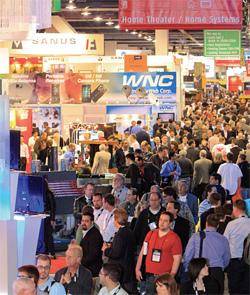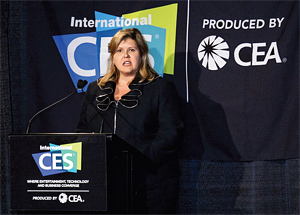Screening CES 2010
LAS VEGAS
3DTV, which still awaits technical standards-setting (expected by mid-2010), will be all over the International Consumer Electronics Show here next month as most of the major TV set manufacturers show off prototypes of their latest 3D concepts.
In addition, Internet-based video delivered directly into more TV sets will be hot as Sony, Samsung, Vizio, Panasonic, LG and most other global brands are plugging a broadband connector into their latest models. Internet widgets for digital TV sets will be ubiquitous, as manufacturers add Web tools to their HD receivers.
FCC Chairman Julius Genachowski, an advocate for all things broadband, will make his first CES appearance as chairman during an interview with CEA President Gary Shapiro at high noon on the show's second day. Broadband—and broadcasting—are inevitable topics for their discussion, including spectrum allocation issues, a topic on which CEA has weighed in aggressively.

CES officials estimate a turnout of 110,000 at the 2010 show, down slightly from 2009. Mobile DTV will get several boosts during CES, Jan. 7-10. The Open Mobile Video Coalition (OMVC) plans to provide details about its Washington, DC, "Consumer Showcase" field trial, set to begin by March. The coalition will also unveil a "broadcaster-developed" Mobile DTV device, according to the group's staff. OMVC is hoping it can announce a deal with a mobile phone carrier that authorizes TV signals into a subsidized handset. Paul Jacobs, CEO of Qualcomm, the company behind the FLO TV technology, is also keynoting and is expected to bring news about his company's next generation mobile video device.
For the living room, in addition to being somewhat thinner, many flat-panel TV sets will be greener. All the big set-makers are introducing light-emitting diode (LED) backlighting for some models of their LCD screens, replacing cold cathode fluorescent lamps (CCFLs) and cutting energy consumption by as much as 40 percent on large-screen devices. Although the move to LEDs has been underway for more than a year, the timing is propitious on the heels of last month's California Energy Commission's drastic new requirements for lower TV set energy consumption. That decision, which CEA vehemently opposed, is likely to be much discussed at an otherwise pro-green CES. Among CEA's concerns is that other states might adopt similar restrictions, "hamper[ing] innovation," as CEA describes it—and more pertinently, wreaking havoc on manufacturers' and retailers' nationwide distribution patterns.
Although CES is traditionally seen as a home hardware show, in recent years, it has recognized the growing opportunities for alternative distribution via new digital platforms. NBC Universal has been an exhibitor for several years, and Yahoo is coming to the show floor as well to demonstrate how its content works on diverse platforms.
CONFERENCES GALORE
Among the new highlights of CES is a star-studded one-day event called "Up Next: Content, Creativity and Cash," focusing on how Hollywood's production and distribution system is being revised to reach viewers via the new platforms, including Internet video and mobile handsets. The program, which starts on Thursday afternoon and continues Friday morning, features panels and speeches from high profile Hollywood, Wall Street and Silicon Valley experts focusing on how to monetize moves into new media. Stephen Chao, president/founder of WonderHowTo.com (and a former Fox TV Studios president), will keynote Up Next; other participants include Screen Actors Guild President Ken Howard, Chris Cookson, president of Sony Pictures Entertainment Technology, Tommy Schlamme, producer of such TV hits as "The West Wing," Vivi Ziegler, president of NBC Universal Digital, and Illeana Douglas, actress and creator/star of the popular Web video series "Easy to Assemble."

Karen Chupka, CEA's senior vice president Another new program, focusing largely on 3DTV, sponsored by the Entertainment Technology Center at the University of Southern California, will include updates on over-the-top video services, mobile distribution and other technologies affecting "next -generation content delivery." Digital Hollywood@CES, another stalwart conference series, spreads its sessions over four days (starting Wednesday, Jan. 6), offering dozens of expert perspectives on cable TV, mobile entertainment, gaming and several hours dealing with "Reinventing Advertising."
FACING ECONOMIC TURMOIL
Typically, the mood of CES relies significantly on what just happened during the holiday selling season. Going into it, CEA predicted that it would be a "deal-driven" period, with shoppers looking for bargains everywhere. Nonetheless, CEA's economists, in their November forecast, stressed that electronics devices were on the wish-lists of 80 percent of Americans, the highest level ever. Hence, they said, volumes would be good, even if margins were tight. Those hopeful words seemed to reflect the mood of many exhibitors as CEA approached.
"Through the year a lot of companies said they were going to compete better when the economy starts to turn," said Karen Chupka, CEA's senior vice president-conferences and events, who oversees the CES exhibits and programs. "So they're investing in new ideas now… Momentum seems to be growing more and more as we get closer to the show."
Chupka saw this cautious approach manifest itself as exhibitors—who in the past might have signed up a year in advance to exhibit their newest wares—waited this year until summer or even late autumn to book display space. Some video vendors who took a few years off from CES floor displays are returning this year, Chupka points out, including Philips, Sanyo and Mitsubishi.
"Lots of companies are focusing on new product development," she said. "They want to be ahead of their competitors. There is optimism about coming out with something new, something beneficial to the consumer." She characterizes vendors as "waiting for the timing of the marketplace," contending that reduced travel budgets for the past year meant that vendors and dealers are eager for a long-overdue opportunity to see each other—and the new product line-ups—during CES.
Overall, about 2,500 exhibitors will show their wares at CES, down from about 2,700 last year. Almost all the exhibits and conference sessions take place in the sprawling Las Vegas Convention Center and adjacent Las Vegas Hilton Hotel. This marks the first time in nearly a decade that CES will not use the Sands Convention Center, another indicator of a somewhat reduced-size show.
But Chupka quickly notes that 330 first-time exhibitors (most of them in small booths) will be on hand. She expects a total turnout of about 110,000 registered attendees, only slightly diminished from last year's 113,000. About 20 percent of CES visitors come from outside the United States, a ratio that has increased over the past few years. At least 80 national "delegations" are coming to Las Vegas for the show, about double the number of such organized groups compared to last year, according to Chupka.
The CES show floor features 22 "Tech Zones," including a new "Experience 3D" pavilion, managed by the 3D At Home Consortium, a group of manufacturers, content creators and broadcasters seeking to speed 3D deployment. Other Tech Zones are devoted to High-Definition Multimedia Interface (HDMI) and another for High Definition Power Line Communication (HD-PLC). OMVC is sponsoring a Mobile DTV TechZone, where Samsung, LG, Harris, Dell and other vendors will showcase their products.
The iPhone Lounge, an exhibit area devoted to the applications and devices for use with Apple's marquee mobile product, makes its debut. Although Apple itself is not involved with the pavilion, dozens of vendors will show their wares. New Tech Zones for eBooks (many of which use airwaves to transmit content to the portable devices) and Wireless Mobility are further reminders about the growing number of product categories that seek a piece of the spectrum.
AROUND THE SHOW FLOOR
Although most TV-set makers are guarding their announcements about product "debuts" until just before CES begins, there were many hints about new devices from October's CEATEC Japan (Combined Exhibition of Advanced Technologies) electronics extravaganza. Among the hits there were Toshiba's Regza LCD TV set built around the cell microprocessor, which was developed by a consortium of IBM, Sony and Toshiba. The chip is similar to one used in Sony's PS3 game console. At CEATEC, Toshiba showed a 55-inch LCD featuring a 240 Hz panel, a 5 million-to-one contrast ratio, LED backlighting and a 3 TB hard disk drive.
Samsung will have about two dozen new TV set models capable of handling Internet access. Although more manufacturers are offering such devices, the Web-enabled receivers represent only about 12 percent of current TV sales. The massive influx of new sets—expected to carry very competitive prices—may fuel the use of Internet video for the living room, especially as more online streaming services become available from companies such as Netflix, Blockbuster, TiVo, YouTube, Yahoo and other sources—all of which will be visible, in one way or another, during CES.
OUTSIDERS CONTINUE TO SURFACE

Toshiba will showcase its REGZA TV line of products, built around a cell microprocessor developed by Toshiba, IBM and Sony. Photo credit: CEATEC CES continues to attract vendors of video-related services that collaborate with home video products. For example, ActiveVideo, an interactive cable TV provider formerly known as ICTV, will unveil an on-demand interface that consolidates search-and-discover access to all of a home viewer's content from a single location, presumably any set-top box or Web-connected CE device.
In an unusual twist for a show dedicated to attract retailers to the products of technology manufacturers, Best Buy, the huge electronics merchant, will have a CES booth. The company has been guarded about the reason for its show floor presence, other than to acknowledge it will be a rallying point for Best Buy employees to experience the CES offerings so that they are better prepared to answer the avalanche of consumer questions that they get after the show.
Despite the notorious temptations of Las Vegas (on the CES show floor and elsewhere around town), CES may become a test of pocketbook power in the wake of the deal-driven holiday shopping season. With many flat-panel displays—even from major brands such as Panasonic and Samsung—now in the sub-$500 range (and some under $400), the industry may move beyond the commodity-based video devices.
At last month's CES preview and the 2010 marketplace in New York, CEA Chief Economist Shawn DuBravac said the "new frugality is here to stay." He predicted a fourth-quarter 8.7 percent growth rate in audio-video product unit sales compared to the same period last year, which saw a 15 percent decline versus that three-month period in 2007. However, with price reductions this year, total fourth quarter A/V sales revenue will drop by about 5.5 percent from 4Q 2008; that is considerably less than the 15.1 percent revenue drop from 2007 to 2008.
DuBravac also focused on "trends to watch," including portable devices and the business partnerships taking place to support them, plus increasing personalization and customization. He also characterized the development of 3D technology as "solidifying."
"3D looks like HD" did a few years ago, DuBravac said, adding that he expects it will be driven by sports, movies and special events, and may experience a growth spurt in about 3-5 years when a version becomes available that does not require special glasses.
That vision suggests there will be more to see in the future of CES, although next month's showcase in the Nevada desert will offer its usual cornucopia of opportunities.
The professional video industry's #1 source for news, trends and product and tech information. Sign up below.
Gary Arlen, a contributor to Broadcasting & Cable, NextTV and TV Tech, is known for his visionary insights into the convergence of media + telecom + content + technology. His perspectives on public/tech policy, marketing and audience measurement have added to the value of his research and analyses of emerging interactive and broadband services. Gary was founder/editor/publisher of Interactivity Report, TeleServices Report and other influential newsletters; he was the long-time “curmudgeon” columnist for Multichannel News as well as a regular contributor to AdMap, Washington Technology and Telecommunications Reports; Gary writes regularly about trends and media/marketing for the Consumer Technology Association's i3 magazine plus several blogs.

